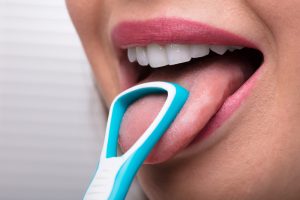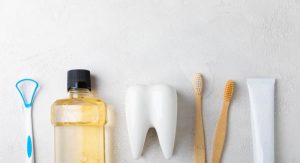

Boost Your Oral Hygiene
Picture the typical morning routine. You roll out of bed, groggy-eyed but determined. You brush your teeth with your favorite minty toothpaste and take a moment to marvel at the sparkling clean smile reflected at you in the mirror. A great start to the morning, right? But what if it’s not enough? What if there’s one often-neglected component to the perfect oral hygiene ritual?
Say hello to tongue scraping — the unsung hero of superior oral health. Explore how this simple yet pivotal practice holds untold benefits ready to revolutionize your dental cleanliness journey. Our dentists in Staten Island created this helpful guide so you can better understand tongue scraping.
Understanding Tongue Scraping
Tongue scraping is the process of using a tool to remove bacteria and debris from the surface of the tongue. The reason behind this is simple; the tongue is home to millions of bacteria that thrive in the warm, moist environment of the mouth. These bacteria can cause bad breath, tooth decay, gum disease, and other oral health problems if left unchecked.
Tongue scraping is an ancient practice that has been used for centuries in traditional medicine to promote overall health. However, it has only recently gained popularity in Western medicine as research has shown its effectiveness in improving oral health and reducing bad breath.
Studies have shown that using a tongue scraper can remove up to 30% more volatile sulfur compounds (the main cause of bad breath) from the tongue than brushing alone. This makes tongue scraping an effective tool for reducing bad breath.
Some people may argue that their toothbrush does a sufficient job of cleaning their tongue. While a soft-bristled toothbrush can help clean the surface of the tongue, it can’t reach deep into the crevices where bacteria tend to gather. Additionally, toothbrushes tend to harbor more bacteria than dedicated tongue scrapers, which can counteract their cleaning benefits.
Different Types of Tongue Scrapers
There are several types of tongue scrapers on the market, each with its advantages and disadvantages.
- Plastic scrapers are generally the most affordable option and can be found at most drug stores. However, they may not be as effective at removing bacteria and debris as other materials.
- Copper scrapers are often recommended for their antimicrobial properties, which can help reduce bacterial growth on the scraper itself.
- Stainless steel scrapers are durable and easy to clean but may be more expensive than other options.
- Silicone scrapers are flexible and gentle on the tongue but may not be as effective at removing debris.
No matter which material you choose, choose a dedicated tongue scraper rather than repurposing household items like spoons or toothbrushes. These items may not be designed specifically for cleaning the tongue and can harbor even more bacteria than a dedicated scraper.
Some people may argue that using a tongue scraper is unnecessary if they brush their teeth regularly. While brushing is important for cleaning teeth and gums, it doesn’t effectively remove bacteria and debris from the surface of the tongue. Additionally, some people may find it uncomfortable or gag-inducing to scrape their tongues.
 Benefits of Tongue Scraping
Benefits of Tongue Scraping
Tongue scraping is a simple yet effective practice that offers numerous benefits for your oral health. It helps remove harmful bacteria, food debris, and dead cells from the surface of the tongue that might cause tooth decay, gum infections, and bad breath. Studies suggest that tongue scraping can remove bacteria and improve bad breath more effectively than brushing.
Enhancing Taste Sensations
Regularly scraping your tongue can enhance taste sensations.
When taste buds are coated with debris or bacteria buildup on the surface of the tongue, they may not function as well, leading to a dulled sense of taste. By removing this buildup through tongue scraping, you can improve the ability of your taste buds to distinguish between different flavors.
For some individuals, this can mean the difference between enjoying their meals and feeling like they’re missing out on the full flavor experience.
Fighting Bad Breath
Bad breath, also known as halitosis, can be embarrassing. Although there are several causes of bad breath, one of the major culprits is the build-up of bacteria on the tongue. This is where tongue scraping can come to the rescue.
Tongue scraping helps remove debris, bacteria, and dead cells from the surface of the tongue that can lead to bad breath while promoting overall oral health. Using a tongue scraper twice daily can also improve the sense of taste by helping the tongue distinguish between bitter, sweet, salty, and sour sensations.
With regular use of a tongue scraper, you can noticeably reduce bad breath and improve your overall oral hygiene. If you’re someone who suffers from bad breath or simply wants fresher breath each day, adding tongue scraping to your dental care routine is worth considering.
How to Effectively Scrape Your Tongue
Tongue scraping is an easy process that only takes a few seconds each day. It’s also cheap as specialized scrapers are priced under $10 at most drug stores.
However, proper technique is important to get the most benefit from tongue scraping:
- Take your tongue scraper and place it near the back of your tongue.
- Gently scrape the surface of your tongue using light pressure. Don’t apply too much pressure – this could cause damage and make your breath worse.
- After each scrape, rinse the scraper under running water to remove any debris.
- Repeat this process 5 to 10 times, starting from the back of your tongue and working forward.
If you find that you start to gag when scraping, try breathing through your nose while doing it. If you’re still uncomfortable, start with a lighter touch until you get used to the sensation. Remember that there are different types of scrapers available as well. Plastic ones are less expensive than metal ones but also less durable and may break sooner than expected.
Potential Side Effects and Precautions of Tongue Scraping
While tongue scraping may seem like a simple and harmless activity, it’s important to note that there are potential side effects and precautions to consider before incorporating it into your daily oral hygiene routine.
One of the most common side effects of tongue scraping is an accidental injury to the tongue or throat. This can occur if too much pressure is applied during scraping or if the scraper is not used properly. Some people may also experience an uncomfortable gag reflex when attempting to scrape the back portion of their tongue. In these cases, take your time and be gentle when performing tongue scraping.
In rare cases, using an unclean or shared tongue scraper can spread infections or diseases like cold sores or strep throat. Clean your scraper thoroughly after each use and avoid sharing it with others. Additionally, people with bleeding gums or other oral health issues should consult with a dentist before adding tongue scraping to their routine, as it may exacerbate certain conditions.
Some people may also experience slight discoloration on their tongues after starting a regular tongue-scraping routine. This is usually temporary and can be attributed to residual buildup being removed from the surface of the tongue. If this discoloration persists or is accompanied by other symptoms, however, it may be a sign of an underlying health issue and should be addressed by a dentist.
Perfect Your At-Home Oral Hygiene Routine!
By adding tongue scraping to your daily oral hygiene routine, you can improve your dental health! Achieve a sparkling smile and avoid dental problems by visiting the dentist twice a year and perfecting your at-home oral hygiene routine.


 Benefits of Tongue Scraping
Benefits of Tongue Scraping